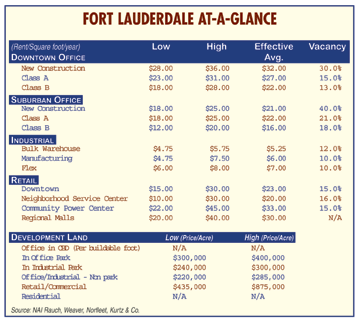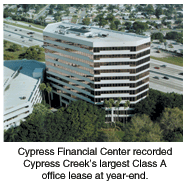SUNNY SOUTH FLORIDA CONTINUES TO GROW, THOUGH SLOWLY
Michael W. Rauch
The demand for commercial investment property is strong in South Florida.
Part of the attraction could be the weather, but more likely,
the real attraction has been the relative value of the property.
For a number of years, South Florida has represented a real value compared
to other parts of the United States. Traditionally, an investor could
buy a property, get a good current income and expect some capital appreciation.
As more and more investors seek the good life in South Florida, prices
are rising and cap rates are declining.
There are significant barriers to entry in the market as well, other than
the current economic uncertainty. There is no major buildable land in
Dade or Broward counties, and leading land experts expect Palm Beach to
run out in the next year or two.
This lack of land means that infill development and redevelopment will
be the next wave. The metropolitan statistical area, which includes Miami-Dade
County and Fort Lauderdale, is expected to grow by over 2 million people
in the next 20 years. This can only mean one thing: rising demand and
increasing prices.
The possibility of buying low and selling high in South Florida is about
the same as being struck by lightning while being handed a
winning lottery ticket. Investors will have to content themselves
with reasonable returns and some capital appreciation while
they wait out the current cycle.

Industrial
Broward County has seen slow but steady absorption in most industrial
submarkets. The heady days of 2 million square feet of absorption per
year are a thing of the past. The most recent figure indicated 2002 would
have a total net absorption of approximately 850,000 square feet for the
year, less than half of the 1.9 million absorbed in 2001.
Overall, the Broward County market is in good condition. Most developers
have ceased construction on speculative projects and are completing only
those that have passed the point of no return. The usual suspects are
still active in the market; they include Stiles, Butters, IDI and a number
of private investors. The trend has been a shift toward build-to-suits
and industrial condos rather than the traditional “build it and they
will come” big box genre.
In Tamarac, Miller Construction Company is fast-tracking construction
of the distribution center and headquarters for Future Metals Inc. The
58,400-square-foot, $3 million building will be located at the Westpoint
Centre business campus within Tamarac Commerce Park. With intensive pre-construction
planning, Miller handled the design phase to meet Future Metals’
timeframe for completion of the facility; the design team includes Retzsch
Lanao Caycedo Architects. Construction is underway with move-in slated
for this spring.
The vast majority of development is taking place in the southwestern portion
of the county, particularly in the Pembroke Pines and Miramar areas along
the corridors of Interstates 75 and 595. However, there is small amount
of in-fill development going on in various areas of the county, particularly
in the central portion.
New development seems to be at a relative standstill, and developers are
seeking to unload the excess property they may have acquired over the
last several years. For the near term it appears that developers will
wait out the current supply and watch for price increases before adding
any new inventory to the industrial market.
Office
Fort Lauderdale is the place to lease office space. Vacancy rates in the
downtown area are as high as 15 to 20 percent excluding sublease space.
Most office projects that were slated for construction but had not broken
ground are now on hold.
Even more telling are landlord concessions. Rental concessions are up
as the office market hovers relatively directionless. Recently, two separate
transactions for office space were negotiated with as much as 6 months’
free rent.
A number of large blocks of space remain on the market, as the landlords
are unable or unwilling to divide the space into smaller suites. Consolidations,
downsizing and mergers have left the downtown area with that empty feeling.
Activity in the smaller spaces has increased slightly over the last few
months while big space users sit out the cycle, waiting and watching for
signs of the double-dip recession.
The suburbs are feeling the pressure as more and more tenants look for
the smaller spaces closer to the home of the boss. One of the factors
that will influence the demand for space is the ever-increasing traffic
issue.
As more and more people arrive in Broward County over the next several
years the woefully inadequate infrastructure will become even more antiquated.
With the expected 900,000 additional residents, more space will be required
and along with the space will come the associated infrastructure problems.
Multifamily
With the current low interest rate environment, many tenants have opted
to buy rather than to rent. This has increased vacancy in most of the
apartment properties and caused rates to flatten or even decline in some
properties.
New homes sales have been brisk as developers put more product on the
market. One example of this is Villa Tuscany, a new luxury residential
project by Fazio Properties and Miller Construction Company in downtown
Fort Lauderdale.
Development of for-sale residences is on the rise, and developers continue
to offer additional amenities to attract potential buyers. A good number
of apartment dwellers have found this combination hard to resist. This
is not the end of the apartment market as we know it; those perennial
apartment dwellers will always be in the market. And with the influx of
those new residents, the future should be sunny for apartment investment
for the next several years.
Investment Sales
Investment sales in South Florida are in a unique condition. In the office
market we have sellers that are holding out for top dollar even as their
rent rolls decline through the mergers, downsizing and outright vacating
of space.
Flight capital is bidding up the price of most well-maintained and well-located
investment properties as cap rates decline further into the single-digit
range. Class A buildings are selling with cap rates well into the single
digits. Even older, tired properties are getting pricey as investors look
for that “safe haven” in which to park their capital.
In one recent transaction of note, a buyer paid over list price for a
1920s vintage two-story warehouse with freight elevators. The property
is not being converted to loft apartments and is not in the direct path
of any development.
Apartments and industrial properties seem to be the current press darlings,
with retail and office rounding out the choices in that order. The prevalent
thinking is that even in an economic downturn everyone still needs a place
to live.
The good news for the industrial market is that it has been less hard
hit than the office market with an overall vacancy rate hovering around
9 to 10 percent. South Florida is fortunate in that approximately 80 to
90 percent of all the freight bound for South and Central America, the
Caribbean and Mexico leaves the country through the three ports in its
market.
Miami International Airport serves as an additional economic buffer with
the main consumers of space being freight forwarders. Surrounding the
airport are all of the airfreight and airline service industries consuming
even more space.
Michael W. Rauch, P.A., is managing partner and vice president of NAI
Rauch, Weaver, Norfleet, Kurtz & Company in Fort Lauderdale, Florida.
|
Intermittent Rays of Light Shine on Cypress
Creek’s Office Sector
Sandra Andersen
 Tenant
demand, largely characterized by the growing insurance
industry, buoyed year-end leasing activity in the Cypress
Creek area of Broward County, Florida. Cypress Creek’s
standing as one of the most desirable suburban office
submarkets, known as Uptown, is due largely to its location
in between Miami and Boca Raton, where it is uniquely
positioned near all of South Florida’s major transportation
arteries. While the office segment of the commercial
real estate sector in general has not been unscathed
by local or national market forces, most trends have
been uneven at best over the last 12 months. Tenant
demand, largely characterized by the growing insurance
industry, buoyed year-end leasing activity in the Cypress
Creek area of Broward County, Florida. Cypress Creek’s
standing as one of the most desirable suburban office
submarkets, known as Uptown, is due largely to its location
in between Miami and Boca Raton, where it is uniquely
positioned near all of South Florida’s major transportation
arteries. While the office segment of the commercial
real estate sector in general has not been unscathed
by local or national market forces, most trends have
been uneven at best over the last 12 months.
Lateral Absorption
The rising star among lease transactions was the 31,000-square-foot
expansion and renewal of the publicly traded insurance firm, Brown
& Brown, at Cypress Financial Center in November. The building
is one of the prized towers of Florida Office Property Company,
one of the largest owners of Class A property in the state. Inter-market
movement includes another major insurance player, Mass Mutual, which
will be relocating 20,000 square feet from Radice Corporate Center
I to 23,000 square feet at 1000 Corporate Dr., to take over the
previously occupied Motorola space. This was a direct deal and,
reportedly, quite aggressive. The landlord was well positioned;
Motorola paid a sizable buy-out and left relatively high-end upgrades
to its space. Unfortunately for the market as a whole, this switch
resulted in a net loss as Motorola left the Cypress Creek area.
Abundant Space Still on the Horizon
Absorption will be boosted by 40,000 square feet in May as Microsoft
moves into the new Cypress Park West II building. That is the good
news. The bad news is, at year-end, 70,000 square feet still remained
available in the new project. Completely vacant is the 100,000-square-foot
1515 West Cypress building, which opened in April 2002. In addition,
Sportsline is looking to sublease its entire 80,000-square-foot
building as it downsizes.
Effect on Pricing
This year’s lower demand levels and lingering vacancy have
impacted rates and produced concessions. While owners of the well-located,
quality buildings are holding firmly on their rental rates, some
are discounting rates by as much as $4 per square foot. While conditions
in the Fort Lauderdale Central Business District remained soft,
transaction activity in Cypress Creek during the fourth quarter
represented a definite “up tick” in the market —
much more than what was anticipated by most market observers.
Sandra Andersen is a vice president with Jones Lang LaSalle.
|
©2003 France Publications, Inc. Duplication
or reproduction of this article not permitted without authorization
from France Publications, Inc. For information on reprints of
this article contact Barbara
Sherer at (630) 554-6054.
|
